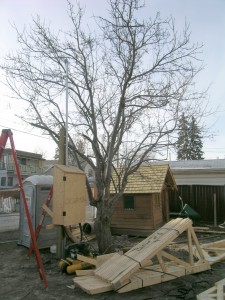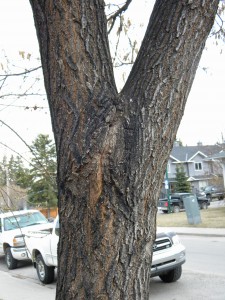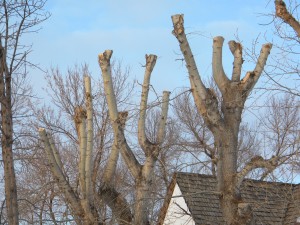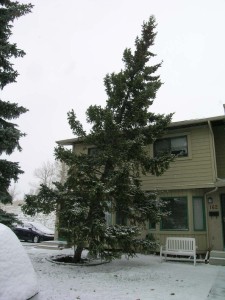Wind Damage
In late April and Early May we saw some severe tree damage due to the storms we had blowing through town. In addition to the snow, we also had some high winds that caused some tree limbs to crack or break as well as some trees that had actually started to uproot (like the tree pictured below).
While this tree didn’t cause much damage, if it had fallen in another direction, the results could have been much worse. Every tree has the potential to fail but not many fall and hit people or property. It is the owner’s responsibility to ensure the safety of the trees on their property. It is important to to note that although it may be simple to identify some of the common defects that may make a tree dangerous, assessing the extent of the hazard is best left to a professional.
Common Signs of Tree Issues
There are some simple signs to look for when identifying possible hazards, they can be caused by a number of things including construction damage to the roots or crown, heavy winds, poor previous pruning or poor tree structure. Trees can also be adversely affected when adjacent trees are removed or die because they rely on the other trees for protection from the forces of wind.
Construction Damage
Construction around trees can cause a number of issues, usually resulting from root damage during excavation or compaction from machinery. This can cause roots to die back making the tree unstable. Roots can be thought of as the anchors for the tree, but they usually don’t extend past 12 inches in depth and are therefore easily damaged by any disturbance. If you know a tree has recently had construction completed around it, special attention should be given to regularly inspect the tree which may require a professional.
Another issue that can cause issues when renovating a property is raising of the grade. As mentioned earlier, tree roots occur mainly in the top 12 inches of the soil. This is because they need to exchange gases with the air and if they are buried under soil, they will suffocate. Adding soil around the tree trunk can also cause rotting of the main stem which will obviously make the tree less stable.
Structure and Pruning Issues
Some things to look for with regards to structure and previous pruning:
- Large dead or detached branches in the canopy
- Cavities or signs of rot in the trunk or main stems
- Cracks or splits in the trunk
- Trees that have been “topped” or severly pruned in the past
Wind Damage
Usually wind damage is a result of another contributing factor. These can include damage to the root system, poor tree structure, or poor previous pruning. Trees that are poorly planted can also be subject to wind damage. The tree first pictured in this post still had burlap and string around the roots when it blew over, as did the tree below.
This tree below also broke due to wind. It had multiple leaders after it had been severely pruned in the past, it fell over onto the neighbour’s house.
This tree had been dead for a while before it fell. It may not be obvious to everyone, but a dead tree can be a significant hazard.
Needless to say, trees can be a liability as well as an asset. It is important to ensure that your trees receive proper care on a regular basis. If you ever feel that your tree may have one of the issues mentioned it is best to contact a professional arborist. They will have the knowledge and experience to help you assess the situation and make decisions. If you require more info on the subject I would recommend visiting the Trees are Good website.








